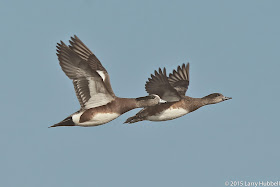…what felt like a bubble of fog and water.
On the last Friday in January the gray, early morning fog made me have second thoughts about crossing Union Bay. Without being able to see land, my only directional clue would have been, to listen for the sound of the 520 construction. Coming out onto the bay just east of Foster Island, I decided I to keep the shore in sight.

No matter how close they came, the rings on the ring-necked ducks were totally invisible.
Further east, a canada goose attempts to wake up. It looked like it was trying to drink the fog, Maybe it was wishing for a cup of coffee.
At the mouth of Montlake Cut, the muffled sound of the early morning traffic was audible, but the bridge was not visible. The cottonwood tree on the northeast corner of The Cut did not contain a single cormorant. Spotting fish through the fog must be quite a challenge.
At the Waterfront Activity Center (WAC), this crow seemed to be listening for the sound of motors.
Above the north end of the WAC dock, an eagle perched in a cottonwood tree.
The incredible eye sight of the eagle seemed wasted in the fog.
Although the eagle had spotted the cormorants and must have moved to improve its view.
The cormorants were silently sitting, just offshore, on this mud bar. As soon as the fog began to thin a bit, the cormorants leaped into the water. Their eagerness to find breakfast, revealed a pile of sticks in the middle of the island. If this is a cormorant nest, it is the first one I have noticed on Union Bay. Cornell says their nests can be on the ground or in trees.
Later, while studying the photos, I noticed one of the birds was wearing a band, with the code ER4. Max, from Tacoma, is checking with the scientists from Oregon State University to see if this bird was banded as part of their salmon study. Last January, we were visited by Harvey (HV9), who was born and banded near Astoria on East Sand Island.
A great blue heron rose out of the reeds, around the same time.
…and the wigeons scattered anytime I raised my camera. The distinction between a camera and a rifle was irrelevant to the ducks.
Near Yesler Swamp, an elegant pintail aligns its tail with a twig, apparently trying to help me remember its name.
On another mud bar, there were more cormorants and five-swans-a-sleeping. There were two adults and three, slightly gray, juvenile swans. The young swans woke up as I passed; apparently, having spent the night. Previously, I have only seen the swans arrive on Union Bay in mid-morning and fly back towards Lake Washington before dark. It would be a nice surprise to have them sleep over. Either way it is always nice to have these winter visitors from the Arctic realm.
As I headed home, another bufflehead flew past. The brisk, crisp, clarity of black and white wings in the bright sunlight is one of the reasons I live in the Northwest. I am not always happy with the gray, but my eyes are certainly filled with joy and appreciation...when the fog lifts.
Have a great day on Union Bay…where nature lives in the city!
Larry



















Thank you, Larry!
ReplyDeleteYou are welcome!
DeleteThanks for spreading the word about cormorant bands, Larry. I have reported your bird and CC'ed you on the message. Max
ReplyDeleteMax
Thank you! It will be great to hear about the history of ER4.
DeleteIt was a great weekend of birding down at the Arboretum. My wife and I went down to find the sapsuckers, and ended up finding 34 other species also! Thanks for posting this.
ReplyDeleteMy checklist:
http://ebird.org/ebird/view/checklist?subID=S21729538
Great Job! I am always trying to keep track of the pileated woodpeckers and I am working on a post about bushtits for next week. Do you happen to remember where in the Arboretum you saw those two species? Either way congratulations on a highly successful birding expedition!
ReplyDeleteThe pileated was actually at the secondary lot, just west of the main parking lot on the trail that heads to foster island. We literally got out of the car and heard his call. He (and it was a he, red malar/moustache stripe) was pretty high up in one of the trees to the east of the parking lot.
DeleteThe bushtits were further out along the trail towards Foster Island. We saw a couple of them with a chickadee and two golden-crowned kinglets. We also saw a larger group of 8 or so on foster island just off the trail.
Max,
DeleteThank you! I believe I understand exactly the locations you mentioned. I usually see the male PW far more often than the female and I seldom see her by herself, maybe once a year. I suspect she is often with him (when not nesting) but a bit more quiet. The bushtits are always fun to watch.
Thanks again!
Larry